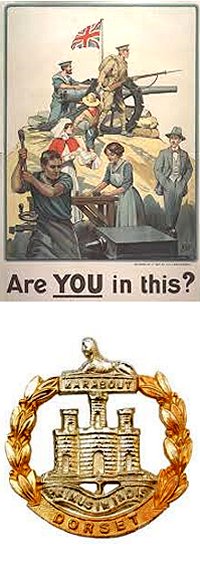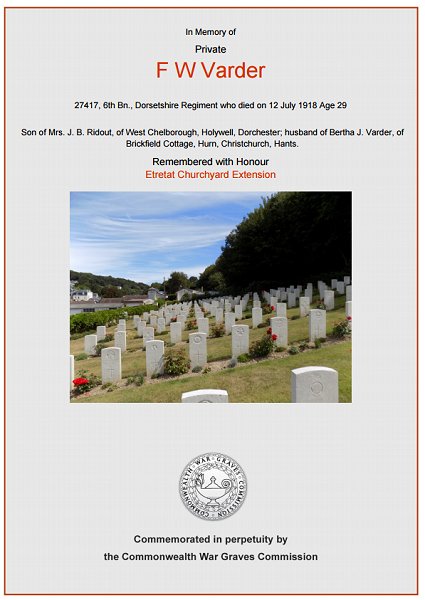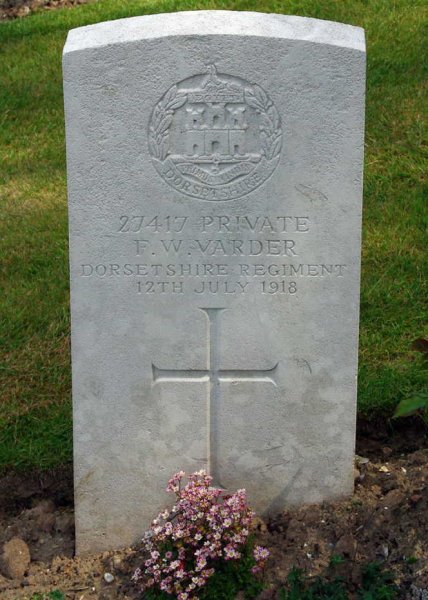yeovil at War
Frederick William Varder
Died of influenza at the beginning of the 1918 Pandemic
Frederick William Varder was born in the spring of 1889 at Yeovil. He was the son of Philip Henry Varder (1860-1896) and Louisa née Gummer (b1858, Westport). In the 1891 census Philip, Louisa and 2-year old Frederick were listed as lodgers at 24 Hendford. Philip listed his occupation as 'Grocer's Outside'. He died in 1896 and in the 1901 census Louisa was listed as a widow living at Hyde Farm, Sutton Bingham, where she worked as the housekeeper. 12-year old Frederick lived on the farm with her. In the summer of 1901 Louisa married John barter Ridout at Yeovil. By the time of the 1911 census 22-year old Frederick was a dairy worker, living with dairyman John Clarke and his family at Closworth.
On 10 December 1911, at Halstock, Dorset, Frederick married Bertha Jane Udall (1888-1959). They were to have a son and a daughter; John (1914-1976) and Frances (1916-1998).
 Frederick
enlisted at
Bridport,
Dorset, giving
his residence as
West Chilborough,
Evershot,
Dorset, joining
the 6th
Battalion,
Dorsetshire
Regiment. His
Service Number
27417 suggesting
he enlisted at
the end of 1917
or the beginning
of 1918.
Frederick
enlisted at
Bridport,
Dorset, giving
his residence as
West Chilborough,
Evershot,
Dorset, joining
the 6th
Battalion,
Dorsetshire
Regiment. His
Service Number
27417 suggesting
he enlisted at
the end of 1917
or the beginning
of 1918.
In 1918 the 6th Battalion, Dorsetshire Regiment were in action in the Battle of St Quentin (21-23 March 1918) and the First Battle of Bapaume (24-25 March 1918), both were phases of the First Battles of the Somme 1918.
The Battle of St Quentin began the German's Spring Offensive on 21 March 1918. It was launched from the Hindenburg Line, in the vicinity of Saint-Quentin, France. Its goal was to break through the Allie lines and advance in a north-westerly direction to seize the Channel ports, which supplied the British Expeditionary Force (BEF) and to drive the BEF into the sea.
Two days later General Ludendorff, the Chief of the German General Staff, changed his plan and pushed for an offensive due west, along the whole of the British front north of the River Somme. This was designed to separate the French and British Armies and crush the British forces by pushing them into the sea. The offensive ended at Villers-Bretonneux, to the east of the Allied communications centre at Amiens, where the Allies managed to halt the German advance; the German Armies had suffered many casualties and were unable to maintain supplies to the advancing troops. Much of the ground fought over was the wilderness left by the Battle of the Somme in 1916. The action was therefore officially named by the British Battles Nomenclature Committee as The First Battles of the Somme, 1918.
The following day the battalion was involved in the First Battle of Bapaume. In the late evening of 24 March, after enduring unceasing shelling, Bapaume was evacuated and then occupied by German forces on the following day. After three days the infantry was exhausted and the advance bogged down, as it became increasingly difficult to move artillery and supplies over the Somme battlefield of 1916 and the wasteland of the 1917 German retreat to the Hindenburg Line. On 25th the troops were ordered to withdraw and reorganise.
Frederick died of influenza on 12 July 1918, at the beginning of what was to become the Influenza Pandemic of 1918. He was aged 29.
Frederick Varder was buried in the Etretat Churchyard Extension, France, Grave II.E.14. His name was added to the War Memorial in the Borough in 2018.
gallery

The Commonwealth War Graves Commission certificate in memory of Frederick Varder.

Frederick Varder's Commonwealth War Graves Commission headstone at Etretat Churchyard Extension, Seine-Maritime, France.